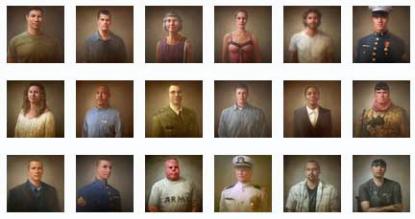It’s all about context.
An amazing portrait is now on display at the National Portrait Gallery in Washington, D.C., as one of 49 finalists for the Outwin Boochever Portrait Competition. The painting depicts Rick Yarosh from the waist up. Yarosh wears a gray Army T-shirt. His expression is hard to read, like the Mona Lisa’s; like Leonardo’s painting, the subject has calm eyes and what looks like the hint of a smile.
Part of what makes Yarosh’s expression hard to read is that his portrait shows no facial hair (eyebrows, eyelashes) and the skin on his face was burned away.
While serving in Iraq, Yarosh’s vehicle was hit by an IED and he subsequently suffered burns on 60% of his body, his right leg was amputated below the knee and his hands sustained injuries that limit their use. In the text that accompanies his portrait, Yarosh states “I'm lucky and blessed to be here, I'm able to share my story with others.” (One of the other two men in the vehicle died from his injuries.)
When viewed in context among the rest of the finalists, this painting seems shocking. It’s like a Diane Arbus photograph in the midst of a Normal Rockwell exhibit. But that’s not really the proper context of this painting.
Rick Yarosh’s portrait is #23 of a series of paintings planned by Matthew Mitchell to be known collectively as the 100 Faces of War Experience. Eventually Yarosh will be joined by the faces of 99 other men and women who traveled from America to the theaters of war in Iraq and Afghanistan. Most of them are veterans, although of the 31 portraits currently on Mitchell’s website, one depicts an anti-war activist and another a civilian combat artist. When completed, Mitchell plans to exhibit all 100 paintings together, with each subject’s statement accompanying his or her portrait.
(Mitchell wrote the previous post on this blog about Yarosh's portrait.)

In this context, Yarosh’s portrait grows in significance.
Just a casual read of the statements shows a huge diversity of opinions on the wars we are still fighting. Those opinions are impossible to categorize based on branch of service, injuries, or theater of war. Browsing through the 100 Faces of War Experience will likely serve to harden one’s opinion of the wars even as each viewer cannot help but feel more compassionate towards the men and women who have experience them firsthand. What changes for the audience is not a new breadth of views on the wars, but a profound depth, a further appreciation for how the experience of war has changed the people of this nation, and through them, the nation itself.
Although the people who have gone to war are just a tiny sliver of the American population, it’s sobering to realize that each of these hundred represents hundreds more like them.
This suggests another context. The NEH has sponsored a program called Picturing America that provides visual resources for classrooms. It’s art history as a way into civics and American history. Mass Humanities has developed its own version of the program and includes a nice lesson plan on American portraits. Rich Yarosh’s portrait and the 100 Faces of War Experience fit very well within the Picturing America resources and I would encourage educators to consider using this project along with Picturing America. The set lessons ask: Can a single portrait represent America? How can the diversity of America be represented in portrait form?
Matthew Mitchell is in the middle of answering those questions. What’s interesting though, is that he’s not answering it as an artist, as Picasso did with Guernica, but as a curator. By establishing that the 100 Faces of War Experience will be kept and seen together, Mitchell is creating a context in which portraits in aggregate can begin to address the complexities of a community dealing with war.
(If you want to vote for Rick Yarosh's portrait for the People's Choice Award, you can go to this page.)


